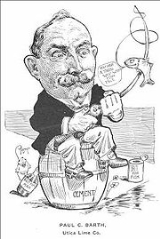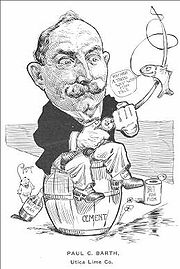
Paul C. Barth
Encyclopedia
Paul C. Barth was Mayor
of Louisville, Kentucky
from 1905 to 1907. The son of a cabinetmaker who died when Barth was 11, he took financial responsibility for the family at an early age. He became sales manager for the Utica Lime Company and founded the Ohio River Sand Company in 1892.
Barth entered politics in 1890 when a retiring member of the Louisville Board of Alderman
chose him as his successor. He was elected that body's president from 1897 to 1898, and again from 1902 to 1905.
Barth ran for mayor in 1905 against Joseph T. O'Neal
, who ran as a Fusionist
– an anti-corruption party with support from Republicans
and Progressives
. Barth had the backing of Democratic
party boss John Whallen and his powerful political machine
. Barth won by over 4,800 votes but the election was fiercely contested by Fusionists, who alleged rampant ballot tampering and voter intimidation had been used by the Democrats.
 The Jefferson County
The Jefferson County
Circuit Court, which had ties to Whallen, upheld the results by a 2 to 1 vote. The Kentucky Court of Appeals
finally ruled the election invalid in May 1907, throwing all Democrats elected in 1905 out of office.
Barth's tenure as mayor was not entirely bogged down in controversy, as he was able to secure $4 million in funding for a new sewage system for the city, a new annex to Louisville City Hall
, and a tuberculosis
hospital, Waverly Hills Sanatorium
. He put up $50,000 of his own money to buy what became Shelby Park for the city, and was eventually reimbursed.
While mayor, Barth purchased an expensive saddle horse with city funds, justifying it as transportation for his duties as mayor. He took the horse with him after being removed from office, and his successor Robert Worth Bingham
made inquiries about the legality of Barth's purchase. The press had a field day, ridiculing the already unpopular Barth over the scandal, and Barth eventually paid for the horse. Upset over the ridicule, Barth shot himself on August 21, 1907 with a 32-caliber revolver in his office lavatory on Main Street.
About 30,000 people were reported to have attended his funeral procession. He was buried in Louisville's St. Louis Cemetery.
Mayor
In many countries, a Mayor is the highest ranking officer in the municipal government of a town or a large urban city....
of Louisville, Kentucky
Louisville, Kentucky
Louisville is the largest city in the U.S. state of Kentucky, and the county seat of Jefferson County. Since 2003, the city's borders have been coterminous with those of the county because of a city-county merger. The city's population at the 2010 census was 741,096...
from 1905 to 1907. The son of a cabinetmaker who died when Barth was 11, he took financial responsibility for the family at an early age. He became sales manager for the Utica Lime Company and founded the Ohio River Sand Company in 1892.
Barth entered politics in 1890 when a retiring member of the Louisville Board of Alderman
Louisville Board of Alderman
The Louisville Board of Alderman consisted of 12 wards and was the legislative branch of government for the City of Louisville prior to the merger of Louisville, Kentucky and Jefferson County in 2003.-History:...
chose him as his successor. He was elected that body's president from 1897 to 1898, and again from 1902 to 1905.
Barth ran for mayor in 1905 against Joseph T. O'Neal
Joseph T. O'Neal
Joseph Thomas O'Neal, Jr, was interim mayor of Louisville, Kentucky, from June to December 1927. His father was a respected Louisville lawyer who ran for mayor in 1905, losing in a rampantly fraudulent election to Paul C. Barth...
, who ran as a Fusionist
Electoral fusion
Electoral fusion is an arrangement where two or more political parties on a ballot list the same candidate, pooling the votes for that candidate...
– an anti-corruption party with support from Republicans
Republican Party (United States)
The Republican Party is one of the two major contemporary political parties in the United States, along with the Democratic Party. Founded by anti-slavery expansion activists in 1854, it is often called the GOP . The party's platform generally reflects American conservatism in the U.S...
and Progressives
Progressivism in the United States
Progressivism in the United States is a broadly based reform movement that reached its height early in the 20th century and is generally considered to be middle class and reformist in nature. It arose as a response to the vast changes brought by modernization, such as the growth of large...
. Barth had the backing of Democratic
Democratic Party (United States)
The Democratic Party is one of two major contemporary political parties in the United States, along with the Republican Party. The party's socially liberal and progressive platform is largely considered center-left in the U.S. political spectrum. The party has the lengthiest record of continuous...
party boss John Whallen and his powerful political machine
Political machine
A political machine is a political organization in which an authoritative boss or small group commands the support of a corps of supporters and businesses , who receive rewards for their efforts...
. Barth won by over 4,800 votes but the election was fiercely contested by Fusionists, who alleged rampant ballot tampering and voter intimidation had been used by the Democrats.

Jefferson County, Kentucky
As of the census of 2000, there were 693,604 people, 287,012 households, and 183,113 families residing in the county. The population density was . There were 305,835 housing units at an average density of...
Circuit Court, which had ties to Whallen, upheld the results by a 2 to 1 vote. The Kentucky Court of Appeals
Kentucky Court of Appeals
The Kentucky Court of Appeals is the lower of Kentucky's two appellate courts, under the Kentucky Supreme Court. Prior to a 1975 amendment to the Kentucky Constitution the Kentucky Court of Appeals was the only appellate court in Kentucky....
finally ruled the election invalid in May 1907, throwing all Democrats elected in 1905 out of office.
Barth's tenure as mayor was not entirely bogged down in controversy, as he was able to secure $4 million in funding for a new sewage system for the city, a new annex to Louisville City Hall
Louisville City Hall
Louisville City Hall is a building in Louisville, Kentucky. Completed in 1873 to house the Louisville city government, the structure is located at 601 West Jefferson Street in what became Downtown Louisville, the center of the city's civic district...
, and a tuberculosis
Tuberculosis
Tuberculosis, MTB, or TB is a common, and in many cases lethal, infectious disease caused by various strains of mycobacteria, usually Mycobacterium tuberculosis. Tuberculosis usually attacks the lungs but can also affect other parts of the body...
hospital, Waverly Hills Sanatorium
Waverly Hills Sanatorium
The Waverly Hills Sanatorium is a closed sanatorium located in southwestern Louisville/Jefferson County, Kentucky. It opened in 1910 as a two-story hospital to accommodate 40 to 50 tuberculosis patients. In the early 1900s, Jefferson County was ravaged by an outbreak of tuberculosis which prompted...
. He put up $50,000 of his own money to buy what became Shelby Park for the city, and was eventually reimbursed.
While mayor, Barth purchased an expensive saddle horse with city funds, justifying it as transportation for his duties as mayor. He took the horse with him after being removed from office, and his successor Robert Worth Bingham
Robert Worth Bingham
Robert Worth Bingham was a politician, judge, newspaper publisher and United States Ambassador to the United Kingdom. He attended the University of North Carolina and University of Virginia but did not graduate. He moved to Louisville in the 1890s and received a law degree from the University of...
made inquiries about the legality of Barth's purchase. The press had a field day, ridiculing the already unpopular Barth over the scandal, and Barth eventually paid for the horse. Upset over the ridicule, Barth shot himself on August 21, 1907 with a 32-caliber revolver in his office lavatory on Main Street.
About 30,000 people were reported to have attended his funeral procession. He was buried in Louisville's St. Louis Cemetery.

